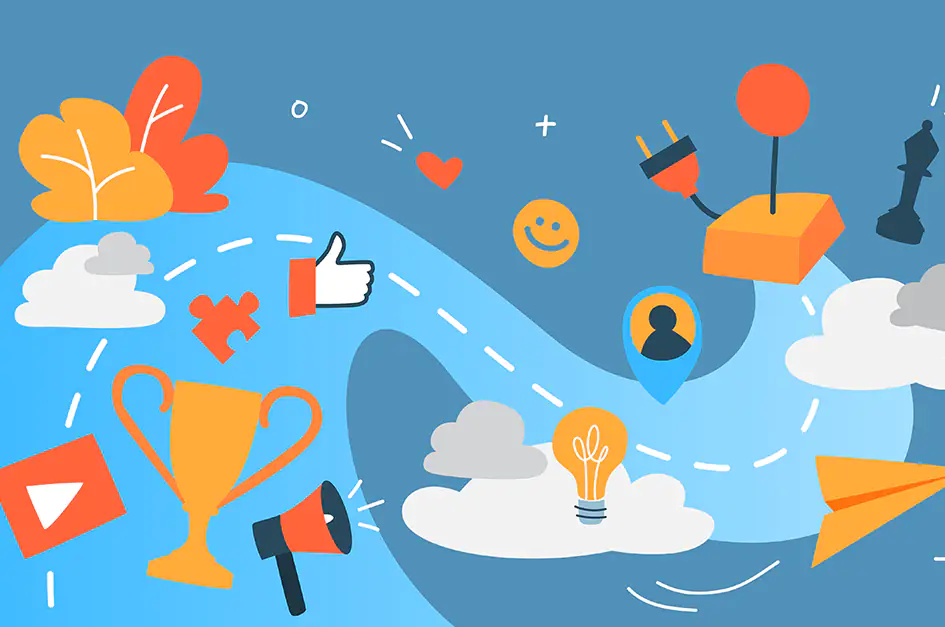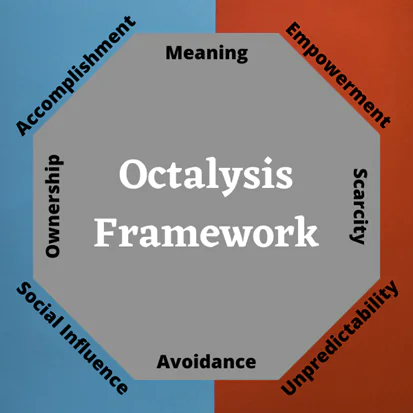
Gamification is being extensively used in eLearning to drive engagement and motivation with the use of game design elements. Acquiring virtual points, completing a series of activities, and competing with fellow learners do bring a fun element to an otherwise severe curriculum. They also stimulate the learner to learn or gain more knowledge, besides helping them easily comprehend difficult concepts.
However, gamification isn’t about the random placement of design elements. It’s a careful study of design principles involving psychological factors. A good gamification design motivates the learner. Hence, when starting with creating a gamification design, it would be ideal to keep the end goal in mind – be it business benefits, learning goals, and so on. That would make it easier to select the right elements for the gamification design.
While there is no one framework or design to suit all learning needs, typically, there are five essential factors that bring out the best in a gamification design.
“Gamification is 75% psychology and 25% technology.” – Gabe Zichermann, a gamification expert and Founder & CEO of Gamification.Co
How to identify the right gamification design elements
It is important to note that replication of an existing gamification design may not necessarily work each time. Every design should ideally bring out personalization for the learner. There also needs to be a balance between all the elements. Overdoing any one element, simply because it seems to click, cannot be the basis of a gamification design.
So, what are some of the best elements that should be introduced in an gamification design for eLearning – without making the elements too obvious?
Here are our top five tips for getting it right:
1. Storyline – A gamification storyline must capture the audience, right at the beginning. It needs to be engaging to grab and sustain the attention of the learner. For example, you can personalize your content or capture the learner’s name, right at the beginning.
These techniques to introduce immersion put the learner in the thick of the action. Having great graphics definitely helps, and so does maybe adding some challenge for the learner. Thus, a compelling and engaging storyline builds the excitement for the completion of a course.
2. Rewards – Rewards provide extrinsic motivation to a learner. A sense of achievement or recognition push the learner to achieve more. Some gamification designs do include penalties as well, though these may not necessarily work.
Instead, badges and stars which are awarded for completing specific actions have proved to be more effective. It helps if the rewards and penalties are closely connected or associated with real-life learning outcomes. Another good idea is exchanging reward points for merchandise or collectibles.
3. Competition – Timers and countdown clocks work great to make the game more interesting. Creating a sense of urgency often helps the learner focus on the task at hand. A gamification design can also have learners compete against themselves. For example, having a leaderboard in the gamification design can provide learners a chance to better their scores.
4. Progression – This is about the way the levels are designed. Progression would mean that higher levels have increased complexity or tougher scenarios which require the learner to go through the multiple learnings they have done till then and apply those.
Learners get satisfaction from successfully completing increasing levels, and this motivates them to put in continued efforts. There could also be increased rewards or increased penalties. Course completion certificates and badges are good examples of progression elements to be used in a gamification design.
5. Feedback – Learners need to know how well they are doing. A performance meter, for example, after every question, can be a good idea to provide the much-needed timely reinforcement. Feedback can be in different formats such as progress bars, encouraging messages, and so on.
In fact, one can also add information nuggets as a feedback mechanism for a wrong answer. Be it immediate feedback or delayed feedback, adding this element to the gamification design makes learners aware of their skill development.
The final trick lies in how all the gamification design elements are assembled to create a lasting experience for the learner. This means an interesting narrative will need a responsive interface along with a dynamic feedback mechanism to collectively enhance knowledge retention.
While that may sound exhaustive, it isn’t about a complex design. Simply put, a good gamification design will have the best elements incorporated into the core of a learning course. It will have a combination of some or all these elements to capture the learner’s interest.
The Octalysis Framework for gamification design
Yu-Kai Chou, a gamification pioneer, designed the Octalysis framework which identifies the eight core drives within humans that motivate us to take up different tasks or activities.
The objective of this blog is not to dive deeper into the Octalysis Framework. However, it would be good to know that any application or experience needs to have at least one of these core drives to engage the user in a real learning experience. These drives throw light on intrinsic and extrinsic motivation factors in humans, and hence make it easier to design a gamification framework.

Harbinger recently helped a US-based fast food retain chain with scenario-based gamified training to train their drive-thru workforce using real-life experiences. Our fun and engaging gamified training solution motivated the workforce to achieve perfection and helped them learn quicker and deliver on the brand’s standards.
Harbinger’s expertise in eLearning gamification
Gamification is one of the most promising ways of elevating learner experience and creating impactful learning. Harbinger’s gamified instructional solution has helped multiple organizations deliver effective business results using a variety of authoring tools like Storyline, Captivate, and HTML5. More so, its award-winning gamification framework has allowed organizations to rapidly add gamification elements to eLearning in a cost-effective way.
Harbinger recently hosted a Power Hour on ‘What Businesses Need to Know about Gamification in Learning’ with industry experts Paul Schneider, SVP – Business Development, dominKnow; Jeanne Bakker, Founder of Brain Bakery; and Vikrant Nene, General Manager – Capability Development, Harbinger Interactive Learning. This interactive webinar was hosted by Dr. Vikas Joshi, CEO of Harbinger Group.

In this session, Vikrant shared interesting ways in which Harbinger uses gamification to quickly develop varied learning experiences. He also gave several examples of different gamification design elements for specific learning objectives.
Gamification is preferred because it triggers human emotions such as excitement and accomplishment for effective learning as well as makes learning more visible. If you too are keen on knowing how gamification can make your eLearning content unique, do reach out to us at contact@harbingergroup.com.






